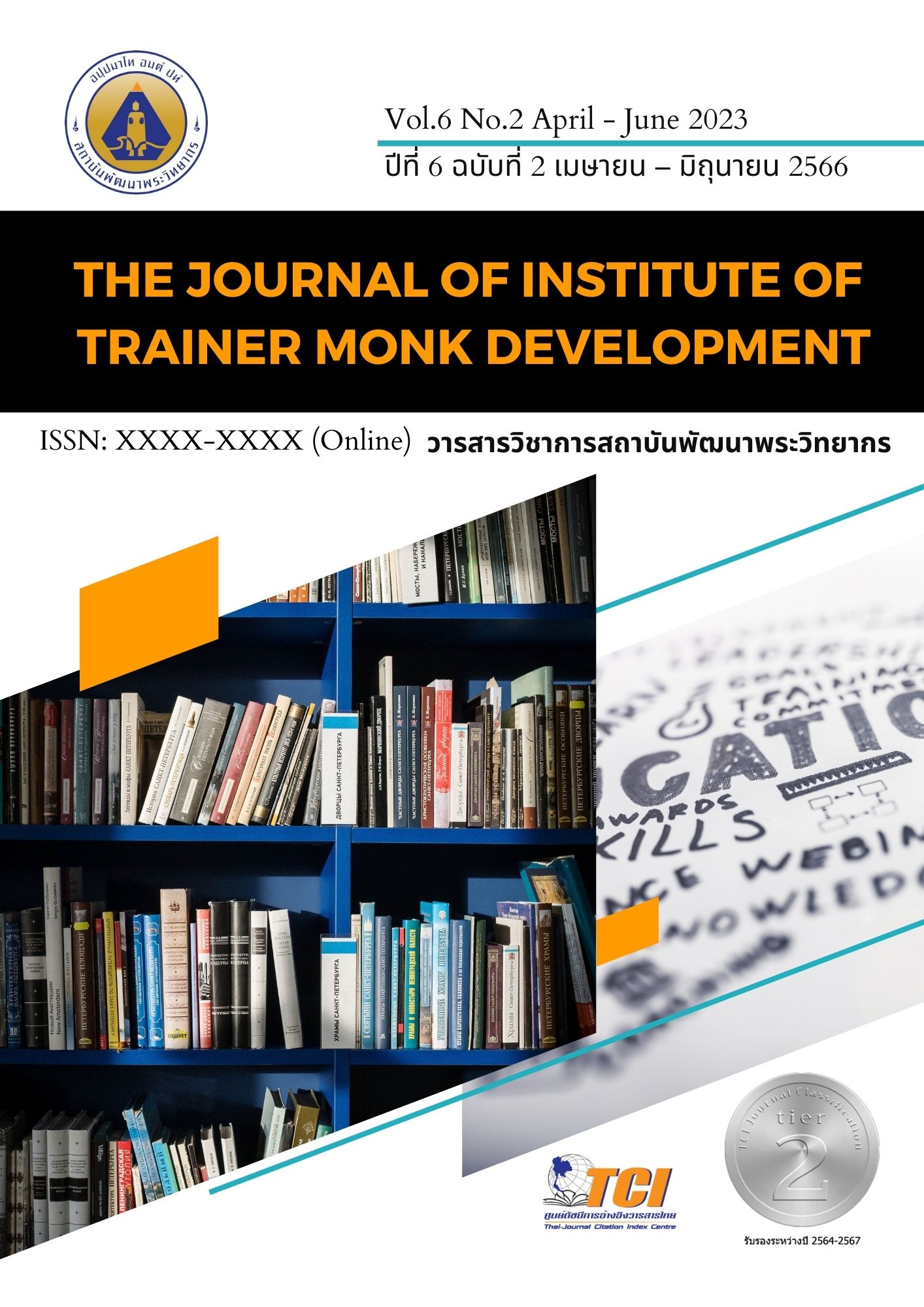The Outcome of Basic Meditation Practice based on the Teaching of Somdet Phra Ñāṇavajirottama (Luangphor Viriyang Sirindharo) of Communities in the Area of Wat Pom Wichien Chotikaram, Mueang District, Samut Sakhon Province
Main Article Content
Abstract
This study the researcher set the objective as follows: 1) to investigate the teaching about meditation practice in Theravada Buddhism; 2) to explore the methods for basic meditation practice based on the teaching of Somdet Phra Ñāṇavajirottama; and 3) to study the outcome of basic meditation practice based on the teaching of Somdet Phra Ñāṇavajirottama of communities in the area of Wat Pom Wichien Chotikaram, Mueang District, Samut Sakhon Province. The study employed qualitative research method in chosen by purposive sampling comprising meditation teachers and meditation instructor course students, totaling 12 persons. The research results were found as follows; 1) From investigating the teaching about meditation practice in Theravada Buddhism, it is found that there are two types as follows: Samatha-kammaṭṭhāna and Vipassanā-kammaṭṭhāna. Meditation is a practice that can help people in developing their minds. According to Buddhism, is to attain the highest goal, which is liberation from all defilements and sufferings. 2) From exploring the methods for basic meditation practice based on the teaching of Somdet Phra Ñāṇavajirottama (Luangphor Viriyang Sirindharo), This meditation instruction course focuses on samatha-kammaṭṭhāna and applies ānāpānasāti (mindfulness of in and out-breathing). The true goal of meditation practice is to achieve the ‘willpower.’ The course has 3 books including both theory and practice, The course lasts six months. 3) From studying the outcome of basic meditation practice based on the teaching of Somdet Phra Ñāṇavajirottama (Luangphor Viriyang Sirindharo) of communities in the area of Wat Pom Wichien Chotikaram, Mueang District, Samut Sakhon Province, The leading to behavioral changes such as physical, mental, family, career, economic, and social changes through both theoretical and practical study. and can continue to practice in their daily lives after the course. it is discovered that the outcome is very efficient.
Article Details

This work is licensed under a Creative Commons Attribution-NonCommercial-NoDerivatives 4.0 International License.
บทความที่ได้รับการตีพิมพ์เป็นลิขสิทธิ์ของวารสารวิชาการสถาบันพัฒนาพระวิทยากร
ข้อความที่ปรากฎอยู่ในบทความที่ได้รับการตีพิมพ์ในวารสาร ถือเป็นความรับผิดชอบของผู้เขียนบทความ และข้อคิดเห็นนั้นไม่ถือว่าเป็นทัศนะและความรับผิดชอบของกองบรรณาธิการวารสารวิชาการสถาบันพัฒนาพระวิทยากร
References
ฐิติรัตน์ รักใจตรง (2548). “ศึกษาการใช้อานาปานสติภาวนาเพื่อพัฒนาคุณภาพชีวิต ของเสถียรธรรม สถาน”. วิทยานิพนธ์พุทธศาสตรมหาบัณฑิต สาขาวิชาพระพุทธศาสนา. บัณฑิตวิทยาลัย: มหาวิทยาลัยมหาจุฬาลงกรณราชวิทยาลัย.
พระครูวิเวกธรรมาภิราม (สงัด วิเวโก). (2558). “ศึกษาการปฏิบัติวิปสสนาภาวนาในภาวนาสูตร”. วิทยานิพนธพุทธศาสตรมหาบัณฑิต สาขาวิชาวิปัสสนาภาวนา. บัณฑิตวิทยาลัย: มหาวิทยาลัยมหาจุฬาลงกรณราชวิทยาลัย.
พระพรหมคุณาภรณ์ (ป.อ. ปยุตโต). (2549). คู่มือชีวิต. กรุงเทพมหานคร: ธรรมสภาและสถาบันบันลือธรรม.
พระมหาอภิวัฒน์ ธมฺมโชโต (รักษาเคน). (2558). “ศึกษาวิเคราะห์แนวทางการปฏิบัติกัมมัฏฐาน ของหลวงปู่มั่น ภูริทตฺโต ตามแนวทางพระพุทธศาสนา”. วิทยานิพนธ์พุทธศาสตรมหาบัณฑิต สาขาวิชาพระพุทธศาสนา. บัณฑิตวิทยาลัย: มหาวิทยาลัยมหาจุฬาลงกรณ์ราชวิทยาลัย.
พระธรรมปิฎก (ป.อ. ปยุตฺโต). (2554). พุทธธรรมฉบับเดิม. กรุงเทพมหานคร: โรงพิมพ์สหธรรมิก.
พระธรรมมงคลญาณ (วิริยังค์ สิรินฺธโร). (2547). 5 ปีในประเทศแคนาดา. กรุงเทพมหานคร: บริษัท ประชาชน จํากัด.
พระศรีปริยัติโมลี (สมชัย กุลจิตโต). (2547). พระพุทธศาสตร์ร่วมสมัย 2. พิมพ์ครั้งที่ 2. กรุงเทพมหานคร: มหาจุฬาลงกรณราชวิทยาลัย.


